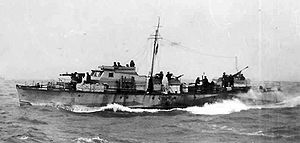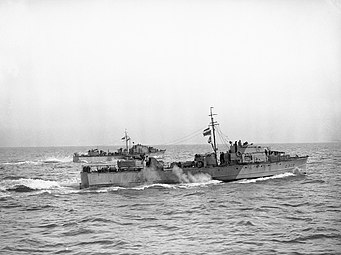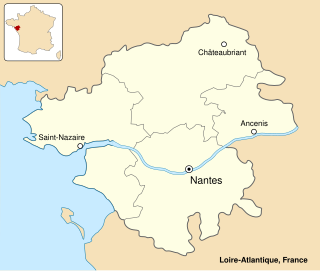
The St Nazaire Raid or Operation Chariot was a British amphibious attack on the heavily defended Normandie dry dock at St Nazaire in German-occupied France during the Second World War. The operation was undertaken by the Royal Navy (RN) and British Commandos under the auspices of Combined Operations Headquarters on 28 March 1942. St Nazaire was targeted because the loss of its dry dock would force any large German warship in need of repairs, such as Tirpitz, sister ship of Bismarck, to return to home waters by running the gauntlet of the Home Fleet of the Royal Navy and other British forces, via the English Channel or the North Sea.
William Alfred Savage, VC was a Royal Navy sailor and a recipient of the Victoria Cross, the highest award for gallantry in the face of the enemy that can be awarded to British and Commonwealth forces.

A motor torpedo boat is a fast torpedo boat, especially of the mid 20th century. The motor in the designation originally referred to their use of petrol engines, typically marinised aircraft engines or their derivatives, which distinguished them from other naval craft of the era, including other torpedo boats, that used steam turbines or reciprocating steam engines. Later, diesel-powered torpedo boats appeared, in turn or retroactively referred to as "motor torpedo boats" for their internal combustion engines, as distinct from steam powered reciprocating or turbine propulsion.

The motor gunboat (MGB) was a small, high-speed British military vessel of the Second World War, which was armed with a mix of guns, in contrast to the physically similar motor torpedo boat (MTB), whose main offensive weapon were torpedoes. The small size of the MGBs, and their high speed, made them difficult targets for German E-boats, though, like their opponents, they were limited by heavy weather, because they did not provide a stable-enough platform to aim the guns. The large number of guns meant the crew was relatively large, numbering as high as thirty men on the largest boats.

The Fairmile B motor launch was a very numerous class of motor launch produced in kit form by British boatbuilder Fairmile Marine, and then assembled and fitted out by numerous boatyards during the Second World War to meet the Royal Navy's coastal operation requirements.
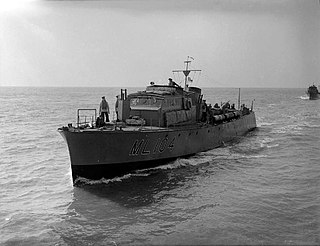
The Fairmile A motor launch was a coastal motor launch designed by Norman Hart for the Fairmile Marine for the Royal Navy in World War II. The prototype ML 100 was privately built by the British industrialist Noel Macklin, who placed an order for this craft on 27 July 1939 with Woodnut's boatyard at St Helens. The Admiralty placed an order for a series of 25 boats to this design on 22 September, including the prototype under construction. The twelve boats completed to this initial design were numbered ML 100 to ML 111, while the thirteen other boats ordered on 22 September were re-ordered to the Admiralty's own Fairmile B design.

The Fairmile D motor torpedo boat was a type of British motor torpedo boat (MTB) and motor gunboat (MGB), conceived by entrepreneur Noel Macklin of Fairmile Marine and designed by naval architect Bill Holt for the Royal Navy. Nicknamed "Dog Boats", they were designed to be assembled in kit form mass-produced by the Fairmile organisation and assembled at dozens of small boatbuilding yards around Britain, to combat the known advantages of the German E-boats over previous British coastal craft designs. At 115 feet in length, they were bigger than earlier MTB or motor gunboat (MGB) designs but slower, at 30 knots compared to 40 knots.

Coastal Forces was a division of the Royal Navy initially established during World War I, and then again in World War II under the command of Rear-Admiral, Coastal Forces. It remained active until the last minesweepers to wear the "HM Coastal Forces" cap tally were taken out of reserve in 1968. The division received more gallantry awards than any other branch of the Royal Navy during that period.

The Coastal Forces of the Royal Canadian Navy (RCN) was a specialized naval force of well-armed, small and fast motor launch (ML) and motor torpedo boat (MTB) flotillas, primarily crewed by members of the Royal Canadian Naval Volunteer Reserve (RCNVR). Tasked with escort, coastal defence, anti-submarine, minesweeping and search and rescue duties, the Coastal Forces of the RCN contributed to securing Allied sea lines of communication off the coasts of Canada and Britain during the Second World War.
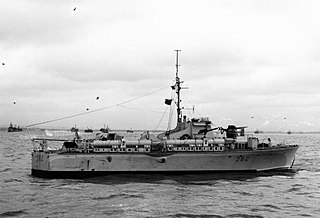
The Vosper 73 foot Motor Torpedo Boat was a mid-twentieth century British motor torpedo boat (MTB) designed by Vosper that served in the Royal Navy Coastal Forces during the Second World War.
HM Motor Gun Boat 501 was a motor gunboat operated by Royal Navy Coastal Forces during the Second World War. The design, prepared by Bill Holt of the DNC's Boat Section, was unusual for a British light coastal forces' boat at the time in that it was of composite construction, whereas most MTBs and Motor Launches were entirely wooden-hulled. MGB 501's frames and various internal members were steel, with layers of diagonal wooden planking forming the exterior skin of the hull and wood for the remaining decks & bulkheads.

HMC ML Q050 was the first of a series of wooden Canadian-built Fairmile B motor launch (ML) boats delivered to the Royal Canadian Navy (RCN) on 18 November 1941. Originally designed for the Royal Navy by W.J. Holt of the British Admiralty and built by British boatbuilder Fairmile Marine, during the Second World War 80 Fairmile B motor launches were built in Canada for service with the Coastal Forces of the RCN.

HMC ML Q051 was a wooden Canadian-built Fairmile B motor launch (M.L.) upgunned submarine chaser delivered to the Royal Canadian Navy (RCN) on 24 November 1941. Originally designed for the Royal Navy by W.J. Holt of the British Admiralty and built by British boatbuilder Fairmile Marine, during the Second World War eighty Fairmile B motor launches were built in Canada for service with the Coastal Forces of the RCN.

HMC MLQ052 was a wooden Fairmile B motor launch (ML) upgunned submarine chaser delivered to the Royal Canadian Navy (RCN) on 31 October 1941. Originally designed for the Royal Navy by W.J. Holt of the British Admiralty and built by British boatbuilder Fairmile Marine, during the Second World War eighty Fairmile B motor launches were built in Canada for service with the Coastal Forces of the RCN.

HMC MLQ053 was a wooden Fairmile B motor launch (ML) upgunned submarine chaser delivered to the Royal Canadian Navy (RCN) on 17 November 1941. Originally designed for the Royal Navy by W.J. Holt of the British Admiralty and built by British boatbuilder Fairmile Marine, during the Second World War eighty Fairmile B motor launches were built in Canada for service with the Coastal Forces of the RCN.
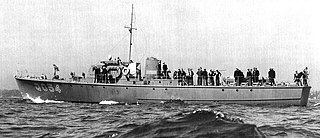
HMC ML Q054 was a wooden Canadian-built Fairmile B motor launch (ML) upgunned submarine chaser delivered to the Royal Canadian Navy (RCN) on 17 October 1941. Originally designed for the Royal Navy by W.J. Holt of the British Admiralty and built by British boatbuilder Fairmile Marine, during the Second World War eighty Fairmile B motor launches were built in Canada for service with the Coastal Forces of the RCN.

HMC ML Q055 was a wooden Canadian-built Fairmile B motor launch (ML) upgunned submarine chaser delivered to the Royal Canadian Navy (RCN) on 6 November 1941. Originally designed for the Royal Navy by W.J. Holt of the British Admiralty and built by British boatbuilder Fairmile Marine, during the Second World War eighty Fairmile B motor launches were built in Canada for service with the Coastal Forces of the RCN.

The Canadian Fairmile B was a motor launch built during the Second World War for the Royal Canadian Navy. They were adaptations of the British Fairmile B motor launch design incorporating slight modifications for Canadian climatic and operational conditions. Eighty-eight were built in Canada for service with the Coastal Forces of the Royal Canadian Navy in home waters, of which eight were supplied to the United States Navy.

HMC MLQ056 was a wooden Canadian-built Fairmile B motor launch (ML) upgunned submarine chaser delivered to the Royal Canadian Navy (RCN) on 23 November 1941. Originally designed for the Royal Navy by W.J. Holt of the British Admiralty and built by British boatbuilder Fairmile Marine, during the Second World War eighty Fairmile B motor launches were built in Canada for service with the Coastal Forces of the RCN.
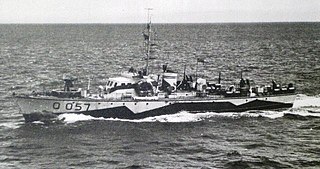
HMC MLQ057 was a wooden Canadian-built Fairmile B motor launch (ML) upgunned submarine chaser delivered to the Royal Canadian Navy (RCN) on 28 October 1941. Originally designed for the Royal Navy by W.J. Holt of the British Admiralty and built by British boatbuilder Fairmile Marine, during the Second World War eighty Fairmile B motor launches were built in Canada for service with the Coastal Forces of the RCN.
